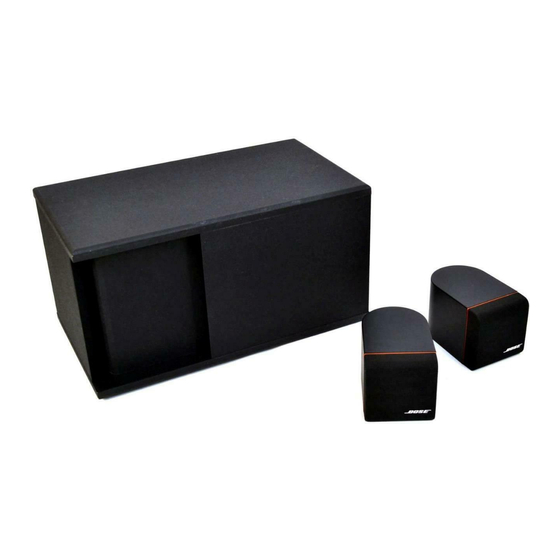Bose AM-3P II Manual - Halaman 9
Jelajahi secara online atau unduh pdf Manual untuk Sistem stereo Bose AM-3P II. Bose AM-3P II 43 halaman.

4. High Frequency (HF) Equalization
High frequency equalization and crossover is achieved through three cascaded active EQ
stages. These stages consist of U103, U104 and U105. The purpose of equalization is twofold:
• It provides very sharp low frequency attenuation below 200 Hz (the crossover frequency)
to prevent overload of the L/R speakers
• It provides finely tailored correction in the speaker passband so that overall frequency
response of the system is acoustically correct
The U103 stage is a combination 2
The U104 stage provides the 5 dB peak at 200 Hz and the sharp band-reject between 100 and
200 Hz. Finally, the U105 stage is a combination 2
Hz notch filter.
5. Bass Control
The bass channel signal is derived from the sum of the left and right channels through resistors
R129 and R229 and through inverting op-amp summer U2. Potentiometer VR3 simply adjusts
the gain of the stage between -6 dB to +6 dB. In the flat (center) position of the control ,the gain
is 0 dB. Adjusting the bass by varying the gain of the overall bass channel has been determined
to be acoustically appropriate to compensate for various placement options of the bass module.
6. Automatic Dynamic Loudness
In order to compensate for the ear's loss of bass response at low listening levels, a BOSE
patented (4,739,513) automatic loudness circuit is employed. This circuit automatically senses
the volume level of the incoming audio signal and properly adjusts the amount of low frequency
bass boost. When the volume level is high, the frequency response of the circuit is flat. When
the volume level is decreased (at the music center), the low frequency gain is increased in the
region between 50 and 150 Hz (see the bass channel frequency response graph, Figure 1 on
page 5). This loudness contour, and the time constants associated with it, have been precisely
determined through psycho-acoustic testing and should not be confused with other conven-
tional loudness schemes.
Circuit operation is as follows: Left and right audio output at pins 7 and 1 of U101 are summed
together by resistors R132 and R232. The AC signal at pin 3 of level detect op-amp U2 is
negative-peak detected and is presented across emitter resistor R9. The peak detected signal
has a (approximate) 4 second hold time and a 4 sec/10 dB release time constant which is
developed within the feedback loop of U2 (pins 1, 2, 3). The voltage across R9 is converted to
a current source through transistor Q3, and flows into pin 5 of transconductance amplifier U4.
U4 is placed in the feedback loop of op-amp U3 to create an inverse voltage controlled
bandpass stage such that increased current into pin 5 of U4 causes the gain of the bandpass
stage to decrease. The 55 Hz bandpass filter consists of resistors R10, R11 and R15 and
capacitors C6 and C7. At frequencies above 200 Hz, the stage acts as a unity gain follower (flat
frequency response) through resistors R16, R17 and R18. The overall loudness contour
response is visible at U3 pin 1.
nd
order 200 Hz high-pass filter and 5 dB 2 kHz dip notch filter.
nd
order 20 kHz low-pass filter and 2 dB 350
9
®
